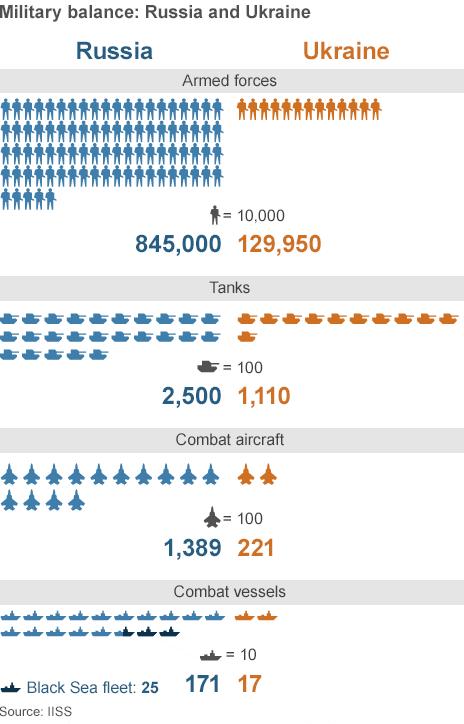Ukraine: The military balance of power
- Published
The military strengths of Russia and Ukraine compared - in 60 seconds
On paper, at least, the Ukrainian military looks credible, though it is numerically inferior to the Russian armed forces - Moscow having about four times as many active troops and twice as many tanks as Kiev.
On the face of things, if Russia were to move into eastern Ukraine, then the Ukrainian forces should be able to put up a better performance than tiny Georgia's armed forces did when the Russians moved onto the offensive in 2008.
But in reality, Ukraine's military is dispersed; it lacks readiness, and much of its equipment is in storage.
Given the divisions inside the country, there must also be question marks about the loyalty of elements of the Ukrainian military to the new interim political authorities in Kiev.

Elite forces
Russia, in contrast, has been exercising some 150,000 troops in military districts bordering eastern Ukraine.
It can also draw upon specialised, capable units like the 7th Guards Airborne Division based at Novorossisk; a variety of special forces formations; and potentially it could deploy elite Interior Ministry forces whose training and equipment might be ideally suited to this kind of mission.
The Ukrainian military inherited a significant quantity of former Soviet equipment at independence.
It is thus in many ways a smaller mirror image of the Russian forces, similarly equipped but having had very little money to modernise over the course of subsequent decades.
It has had some limited, small-scale experience in Nato operations. Its force structure has been modernised to a certain extent. But it is far from cutting edge, with much of its equipment moth-balled or poorly maintained.
Ukraine is also on its own. It is certainly a partner country of Nato but it has none of the security guarantees that membership of the Atlantic Alliance would bring. There is simply no question of Nato becoming militarily involved in this crisis.
Russia was from the outset in the driving seat in the Crimea. Its deployments there dwarf Ukraine's limited forces in the region.
Russian reinforcements
While the Black Sea Fleet itself is now rather out-dated and in any case one of Russia's smaller naval forces, its military bases there gave it more than sufficient manpower to take over key installations and blockade Ukrainian units inside their bases.

Over the past few days, Russian reinforcements have been arriving but Moscow retains the option of sending in many more units if any actual fighting breaks out.
So far, Russia's military operation has been largely bloodless. Its forces have met with only some passive resistance from Ukrainian units, who can do very little.
Perhaps the initial military phase of this crisis is largely at an end. However, if Russian troops were to move into eastern Ukraine it could take this drama to a whole new level.
It is not so much that there would be full-scale mechanised warfare - though clearly some Ukrainian units might fight.
The greater danger is that such a move could prompt a bitter civil struggle with pro- and anti-Russian groups mobilising against each other.